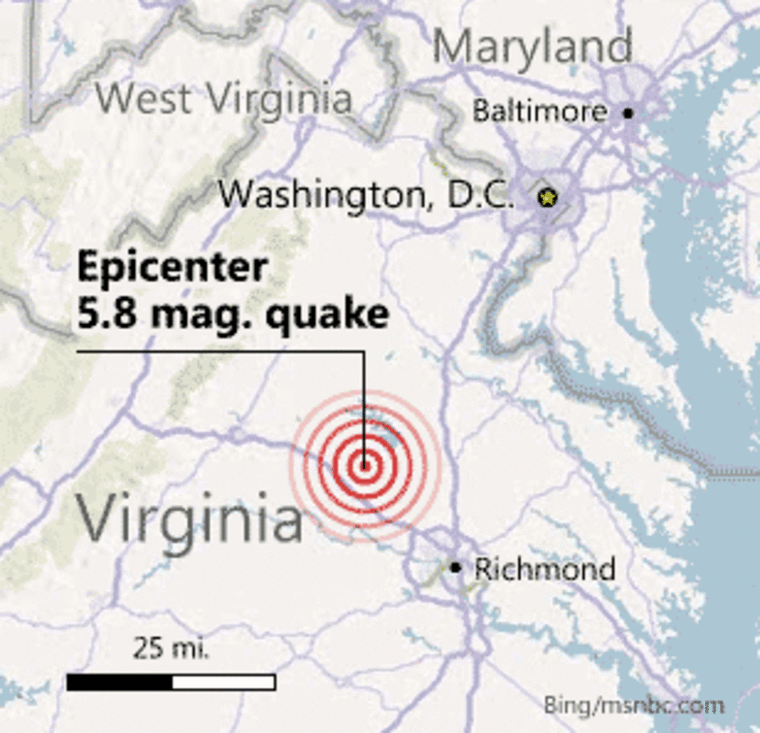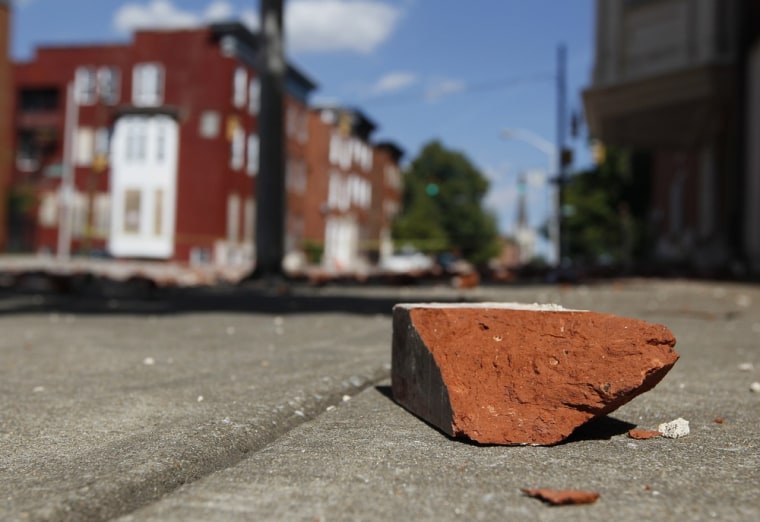Soon after the lunch plates stopped rattling and books stopped thumping to the floor, shaken easterners could hear another sound from Tuesday's magnitude-5.8 quake: snickering emanating from the opposite side of the continent.
"Really all this excitement over a 5.8 quake??? Come on East Coast, we have those for breakfast out here!!!!" wrote Dennis Miller, 50, a lifelong California resident whose house in Pleasanton sits on an earthquake fault line.
On Twitter and Facebook and over email, people circulated a photo of a table and four plastic lawn chairs in a serene garden setting. One of the chairs flipped on its back. The mock image carried the title "DC Earthquake Devastation."
All the more laughable for some were the images of people fleeing buildings — the exact opposite of what you're supposed to do in a quake.
"Hey East Coast, the entire West Coast is mocking you right now," tweeted Todd Walker, an Anchorage TV anchorman.
Later Tuesday, a small earthquake centered near Oakland shook the San Francisco Bay area. The magnitude-3.6 quake struck at about 11:36 p.m. PDT and was also felt by people across the bay in San Francisco.

The tough earthquake talk comes from a coast that is apparently jaded by its own seismic activity — or perhaps not as experienced as it imagines itself to be.
Tuesday's quake was the East Coast's largest since 1944. California alone has seen 35 quakes of that size since then, and since Japan's massive 9.0 quake on March 11, that country has experienced 93 aftershocks that registered more than magnitude-6.0.
The flippancy partly disguises how serious the quakes are taken in California, Alaska and other earthquake-prone parts of the country.
Many West Coast residents are trained to dive under desks and tables when the shaking starts and there is a recognition that temblors of similar size to the one that hit Virginia have caused deaths and millions of dollars of damage here.
Despite the frequency of middling temblors, many people haven't experienced a truly earth-shaking quake. The last major metropolitan-scale disaster was all the way back in 1994, when the magnitude-6.7 Northridge quake ravaged greater Los Angeles.
Joanne Razo, a legal assistant who lives in Washington, D.C., has lived through an earthquake in Los Angeles and said she knows that a 5.8-quake is mild by West Coast standards. But for her, the scary part was not the ground shaking but that "this area is not equipped to handle anything like this."
'Sense of pride'
Andrew Lakoff, a University of Southern California anthropology and sociology professor who studies cultural responses to disasters, said West Coasters seemed to be reacting to scenes of East Coasters losing their cool over the quake. In California, where there is firsthand knowledge of what large quakes look like, something magnitude-5.9 is a relatively minor threat.
"A perverse consequence of living with the ongoing specter of catastrophe is this sense of pride," he said.

Marcus Beer, a video game critic who moved to Los Angeles in 2002 after growing up in the seismically stable British nation of Wales, said he didn't unleash his own smart-alecky tweet about the quake until he saw that it hadn't caused any major damage or harm.
He said he was amused by how much media attention was being seized by a quake of a size that — barring serious damage — would prompt little more than a few nervous chuckles on the West Coast.
"For me, it was just ironic that the major news centers being based on the East Coast finally got hit by what we consider a temblor and it's, 'Oh my God!'" Beer said. "We get those all the time, and we're so used to them."
Some East Coasters seemed to understand the eye-rolling from the West Coast. On Foursquare, a service that lets people tell others where they've been, users all over the East Coast checked in to made-up locations such as "Earthquakepocalypse," just as they checked in to "Snowpocalypse" during winter storms.
Sarah Atkinson, a manager for a marketing firm in San Jose, was unimpressed by all the excitement.
"5.9? That's what us Californians use to stir our coffee with," she tweeted.
Centered in Virginia, Tuesday's quake forced hundreds of thousands of people to evacuate buildings in New York, Washington and other cities. There were no reports of deaths or serious injuries.
In the Washington area, parts of the Pentagon, White House and Capitol were among the areas evacuated for several hours.
At the majestic Washington National Cathedral, at least three of the four top stones on the central tower fell off, and cracks appeared in the flying buttresses at the cathedral's east end, the oldest part of the structure
National Park Service officials discovered a crack in the stones near the top of the Washington Monument. Structural engineers will be brought in to evaluate the cracks. The 91,000-ton monument is made of Maryland marble.
At the Pentagon, a low rumbling built and built to the point that the building shook. People ran into the corridors of the government's biggest building and as the shaking continued there were shouts of "Evacuate! Evacuate!"
NBC News' Pentagon corespondent Jim Miklaszewski said the rumbling was eerily similar to the impact on Sept. 11, 2001, when al-Qaida terrorists flew a jetliner into the Pentagon. "I, like many other people here, thought: 'Oh my God, we've been hit again.'"
The quake was tied for third strongest along the East Coast in recorded history, USGS records show. Charleston, S.C., was hit by a 7.3 in 1886 and Giles County, Va., saw a 5.9 in 1897. A 5.8 quake struck New York state in 1944.
In New York City, NBC News reported debris fell from the attorney general's office, causing panic as people ran from the area.
Airport towers and government buildings in New York, including City Hall, were evacuated. The 26-story federal courthouse in lower Manhattan began swaying and hundreds of people were seen leaving the building.
'I ran down all 60 flights'
With the 10th anniversary of the Sept. 11 terrorist attacks just weeks away, people were shaken physically and emotionally and poured from high-rises like the Empire State Building in New York, sick with mental images of planes and bombs.
"I ran down all 60 flights," accounting office worker Caitlin Trupiano said. "I wasn't waiting for the elevator."
The earthquake that devastated Japan released more than 60,000 times more energy than Tuesday's.
The steeple and bell tower at St. Patrick Catholic Church in Baltimore were badly damaged, and the building was closed as a precaution.
In Reading, Pa., highway inspectors shut down a bridge after spotting cracks in an abutment, but later said they might have been there before.
In West Virginia, environmental regulators sent engineers to inspect massive coal slurry dams that could wipe out entire communities if they were to fail and release billions of gallons of wastewater.